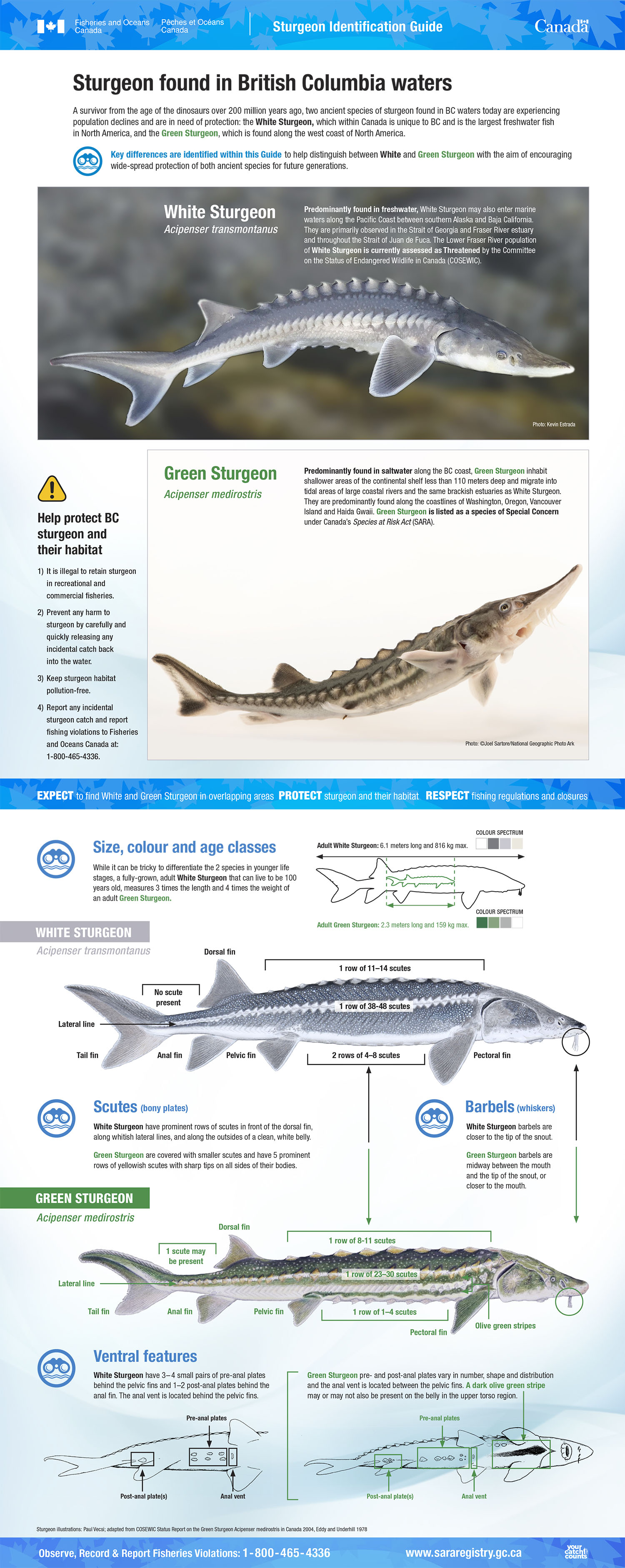Sturgeon identification guide: Sturgeon found in British Columbia waters

Description: Sturgeon found in British Columbia waters
Sturgeon found in British Columbia waters
A survivor from the age of the dinosaurs over 200 million years ago, two ancient species of sturgeon found in BC waters today are experiencing population declines and are in need of protection: the White Sturgeon, which within Canada is unique to BC and is the largest freshwater fish in North America, and the Green Sturgeon, which is found along the west coast of North America.
Key differences are identified within this Guide to help distinguish between White and Green Sturgeon with the aim of encouraging wide-spread protection of both ancient species for future generations.
White Sturgeon (Acipenser transmontanus)
Predominantly found in freshwater, White Sturgeon may also enter marine waters along the Pacific Coast between southern Alaska and Baja California. They are primarily observed in the Strait of Georgia and Fraser River estuary and throughout the Strait of Juan de Fuca. The Lower Fraser River population of White Sturgeon is currently assessed as Threatened by the Committee on the Status of Endangered Wildlife in Canada (COSEWIC).
Green Sturgeon (Acipenser medirostris)
Predominantly found in saltwater along the BC coast, Green Sturgeon inhabit shallower areas of the continental shelf less than 110 meters deep and migrate into tidal areas of large coastal rivers and the same brackish estuaries as White Sturgeon. They are predominantly found along the coastlines of Washington, Oregon, Vancouver Island and Haida Gwaii. Green Sturgeon is listed as a species of Special Concern under Canada’s Species at Risk Act (SARA).
Help protect BC sturgeon and their habitat
- It is illegal to retain sturgeon in recreational and commercial fisheries.
- Prevent any harm to sturgeon by carefully and quickly releasing any incidental catch back into the water.
- Keep sturgeon habitat pollution-free.
- Report any incidental sturgeon catch and reportfishing violations to Fisheries and Oceans Canada at: 1-800-465-4336
Expect to find White and Green Sturgeon in overlapping areas. Protect sturgeon and their habitat. Respect fishing regulations and closures.
Size, colour and age classes
While it can be tricky to differentiate the 2 species in younger life stages, a fully-grown, adult White Sturgeon that can live to be 100 years old, measures 3 times the length and 4 times the weight of an adult Green Sturgeon.
Diagram comparing White and Green Sturgeon size:
- Adult White Sturgeon: 6.1 meters long and 816 kg max.
- Adult Green Sturgeon: 2.3 meters long and 159 kg max.
Diagram of White Sturgeon (Acipenser transmontanus) with the following:
- Lateral line
- No scute present
- Dorsal fin
- 1 row of 11–14 scutes
- Pectoral fin
- 1 row of 38-48 scutes
- 2 rows of 4–8 scutes
- Pelvic fin
- Anal fin
- Tail fin
Scutes (bony plates)
White Sturgeon have prominent rows of scutes in front of the dorsal fin, along whitish lateral lines, and along the outsides of a clean, white belly.
Green Sturgeon are covered with smaller scutes and have 5 prominent rows of yellowish scutes with sharp tips on all sides of their bodies.
Barbels (whiskers)
White Sturgeon barbels are closer to the tip of the snout.
Green Sturgeon barbels are midway between the mouth and the tip of the snout, or closer to the mouth.
Diagram of Green Sturgeon (Acipenser medirostris) with the following:
- Lateral line
- 1 scute may be present
- Dorsal fin
- 1 row of 8-11 scutes
- Olive green stripes
- Pectoral fin
- 1 row of 23–30 scutes
- 1 row of 1–4 scutes
- Pelvic fin
- Anal fin
- Tail fin
Ventral features
White Sturgeon have 3–4 small pairs of pre-anal plates behind the pelvic fins and 1–2 post-anal plates behind the anal fin. The anal vent is located behind the pelvic fins.
Diagram of White Sturgeon with the following:
- Post-anal plate(s)
- Pre-anal plates
- Anal vent
Green Sturgeon pre- and post-anal plates vary in number, shape and distribution and the anal vent is located between the pelvic fins. A dark olive green stripe may or may not also be present on the belly in the upper torso region.
Diagram of Green Sturgeon with the following:
- Post-anal plate(s)
- Pre-anal plates
- Dark olive green stripe
- Anal vent
Observe, Record & Report Fisheries Violations: 1-800-465-4336
- Date modified: